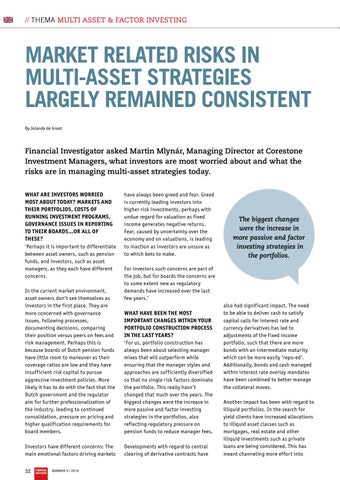// THEMA MULTI ASSET & FACTOR INVESTING
MARKET RELATED RISKS IN MULTI-ASSET STRATEGIES LARGELY REMAINED CONSISTENT By Jolanda de Groot
Financial Investigator asked Martin Mlynár, Managing Director at Corestone Investment Managers, what investors are most worried about and what the risks are in managing multi-asset strategies today. WHAT ARE INVESTORS WORRIED MOST ABOUT TODAY? MARKETS AND THEIR PORTFOLIOS, COSTS OF RUNNING INVESTMENT PROGRAMS, GOVERNANCE ISSUES IN REPORTING TO THEIR BOARDS…OR ALL OF THESE? ‘Perhaps it is important to differentiate between asset owners, such as pension funds, and investors, such as asset managers, as they each have different concerns. In the current market environment, asset owners don’t see themselves as investors in the first place. They are more concerned with governance issues, following processes, documenting decisions, comparing their position versus peers on fees and risk management. Perhaps this is because boards of Dutch pension funds have little room to maneuver as their coverage ratios are low and they have insufficient risk capital to pursue aggressive investment policies. More likely it has to do with the fact that the Dutch government and the regulator aim for further professionalization of the industry, leading to continued consolidation, pressure on pricing and higher qualification requirements for board members. Investors have different concerns: The main emotional factors driving markets 32
FINANCIAL INVESTIGATOR
NUMMER 4 / 2016
have always been greed and fear. Greed is currently leading investors into higher risk investments, perhaps with undue regard for valuation as fixed income generates negative returns. Fear, caused by uncertainty over the economy and on valuations, is leading to inaction as investors are unsure as to which bets to make.
The biggest changes were the increase in more passive and factor investing strategies in the portfolios.
For investors such concerns are part of the job, but for boards the concerns are to some extent new as regulatory demands have increased over the last few years.’
WHAT HAVE BEEN THE MOST IMPORTANT CHANGES WITHIN YOUR PORTFOLIO CONSTRUCTION PROCESS IN THE LAST YEARS? ‘For us, portfolio construction has always been about selecting manager mixes that will outperform while ensuring that the manager styles and approaches are sufficiently diversified so that no single risk factors dominate the portfolio. This really hasn’t changed that much over the years. The biggest changes were the increase in more passive and factor investing strategies in the portfolios, also reflecting regulatory pressure on pension funds to reduce manager fees. Developments with regard to central clearing of derivative contracts have
also had significant impact. The need to be able to deliver cash to satisfy capital calls for interest rate and currency derivatives has led to adjustments of the fixed income portfolio, such that there are more bonds with an intermediate maturity which can be more easily ‘repo-ed’. Additionally, bonds and cash managed within interest rate overlay mandates have been combined to better manage the collateral moves. Another impact has been with regard to illiquid portfolios. In the search for yield clients have increased allocations to illiquid asset classes such as mortgages, real estate and other illiquid investments such as private loans are being considered. This has meant channeling more effort into
